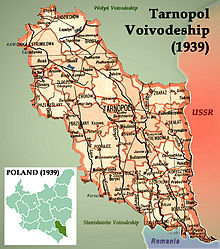Tarnopol Voivodeship

The Tarnopol Voivodeship was an administrative unit of the Second Polish Republic in the years 1921-1939 , which was created on September 1, 1921 when the formerly Austrian part of Poland , Galicia , was divided into the Voivodeships of Lviv , Cracow , Stanislau and Tarnopol. The seat of the administration and the capital was Tarnopol (today Ternopil in Ukrainian ).
location and size
The voivodeship with the cities of Tarnopol , Złoczów , Brody , Brzeżany and Zbaraż extended over the southern part of eastern Poland .
It bordered the Volyn Voivodeship to the north , the Soviet Union along the Dniester River to the east , Romania to the southeast along the Bug River , the Stanislav Voivodeship to the southwest and the Lviv Voivodeship to the west .
The landscape was hilly and shaped by the Podolia landscape. The rivers Dniester, Sbrutsch and Seret flowed through the voivodship .
In 1921 the voivodship covered an area of 16,533 km². The 35 cities and 1,087 rural communities were divided into 17 powiats .
Today the area belongs entirely to Ukraine .
history
The voivodeship was established on September 1, 1921 after the end of the fighting in the course of the Polish-Soviet War in the eastern parts of the former Austrian crown land of Galicia, with Tarnopol as the capital .
On July 1, 1925, the seat of the Husiatyn Powiat was moved to Kopyczyńce and the Kopyczyńce Powiat was created.
In September 1939, during World War II, the voivodeship was occupied by the Soviets during the Soviet occupation of eastern Poland and by Germany after the attack on the Soviet Union in 1941 . After the end of World War II, the area of the voivodeship became part of the Soviet Union ( Ukrainian SSR ).
climate
The voivodeship was on the border of marine and continental climates , which resulted in some weather anomalies. So was z. B. Tarnopol one of the coldest cities in Poland and the area around Zaleszczyki one of the warmest in the state. Strong winds and, depending on their direction, rapid temperature changes were also characteristic. The first frosts often appeared in September and the last in May.
Administrative subdivision (1934)
Powiat Borszczów consisting of the cities of Borszczów, Mielnica Podolska and Skała Podolska as well as the Gminas :
Powiat Brody consisting of the city of Brody and the Gminas :
Powiat Brzeżany consisting of the towns of Brzeżany and Kozowa as well as the Gminas :
- Budyłów
- Buszcze
- Brzeżany
- Koniuchy
- Kozowa
- Kurzany
- Narajów Miasto
- Potutory
- Płaucza Mała
Powiat Buczacz consisting of the towns of Barysz , Buczacz, Jazłowiec and Monasterzyska as well as the Gminas :
- Jazłowiec I
- Jazłowiec II
- Jezierzany
- Koropiec
- Monasterzyska
- Petlikowce starlings
- Podzameczek
- Potok Zloty I.
- Potok Zloty II
- Trybuchowce
- Uście Zielone
- Zubrzec
Powiat Czortków consisting of the cities of Czortków and Jagielnica as well as the Gminas :
- Biała
- Białobożnica
- Dżuryn
- Jagielnica I
- Jagielnica II
- Kolędziany
- Kosów
- Pauszówka
- Świdowa
- Ułaszkowce
Powiat Kamionka Strumiłowa consisting of the towns of Kamionka Strumiłowa and Busk as well as the Gminas :
- Dobrotwór
- Kamionka Strumiłowa
- Nieznanów
- Grabova
- Busk
- Milatyn Nowy
- Żelechów Wielki
- Dziedziłów
Powiat Kopyczyńce consisting of the towns of Chorostków , Husiatyn and Kopyczyńce as well as the Gminas :
- Chorostków
- Czarnokońce Wielkie
- Horodnica
- Husiatyn
- Kopyczyńce
- Probużna
- Sidorów
- Sukhostav
- Wasylkowce
Powiat Podhajce consisting of the city of Podhajce and the Gminas :
Powiat Przemyślany consisting of the towns of Gliniany and Przemyślany and the Gminas :
Powiat Radziechów consisting of the cities of Radziechów and Łopatyn as well as the Gminas :
- Chołojów
- Laszków
- Ohladów
- Radziechów
- Sieńków
- Stojanów
- Szczurowice
- Toporów
- Witków Nowy
Powiat Skałat consisting of the towns of Grzymałów , Podwołoczyska and Skałat as well as the Gminas :
- Bogdanówka
- Grzymałów
- Kaczanówka
- Kołodziejówka
- Krasne
- Ostapie
- Podwołoczyska
- Skałat Stary
- Touste
- Turówka
Powiat Tarnopol consisting of the towns of Tarnopol and Mikulińce and the Gminas :
- Baworów
- Berezowica Wielka
- Borki Wielkie
- Cebrów
- Chodaczków Wielki
- Hłuboczek Wielki
- Ihrowica
- Jankowce
- Janówka
- Jastrzębowo
- Kozłów I
- Kozłów II
- Łozowa
- Mikulińce
- Nastasów
Powiat Trembowla consisting of the towns of Budzanów and Trembowla as well as the Gminas :
Powiat Zaleszczyki consisting of the towns of Zaleszczyki and Tłuste as well as the Gminas :
- Kasperovce
- Koszyłowce
- Drohiczówka
- Sińków
- Tłuste Wieś
- Uhryńkowce
- Uścieczko
- Zaleszczyki
Powiat Zbaraż consisting of the city of Zbaraż and the Gminas :
Powiat Zborów consisting of the cities of Zborów, Pomorzany and Załoźce as well as the Gminas :
- Bogdanówka
- Hukałowce
- Olejów
- Pomorzany
- Załoźce
- Zborów
- Jezierna
Powiat Złoczów consisting of the cities of Złoczów, Olesko and Sasów as well as the Gminas :
population
In 1931 1,600,406 people lived on 16,500 km² - including 789,114 (49.3%) Poles, 728,135 (45.5%) Ukrainians, 78,932 (4.9%) Jews, 4,225 (0.3%) others.
economy
The voivodeship was strongly characterized by agriculture. There was an agricultural product processing industry in the cities. The agricultural trade fairs in Tarnopol and Ułaszkowce were well known across national borders. In terms of mineral resources, there was phosphorite and lignite.


